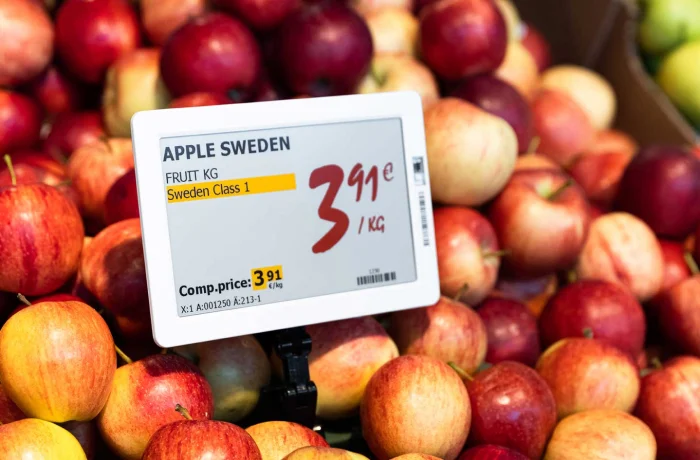Faced with a familiar list of shocks around growth, margins, inflation, supply chain disruption and geopolitical risk, supermarkets don’t just need to be efficient; they need to be agile, says Peter Ward, Regional Sales Director UK & Ireland, Pricer
Our latest UK Grocery Shopper Pulse shows that value vigilance is now mainstream; 78% of shoppers say they’re more price conscious, 74% actively seek discounts and 63% will visit multiple stores for better prices. At the same time, operational reliability matters most; the number one in-store friction is checkout delay (55%), and the single most requested shelf-edge improvement is alerts to staff when shelves are empty (53%).
Amid this pressure, it’s time to rethink what enables agility. While dynamic pricing and automation get the headlines, the real enabler is more fundamental, the shelf. Specifically, electronic shelf labels (ESLs) are no longer a niche utility, they are strategic infrastructure for an intelligent, connected store.
At Pricer, we see this up close. ESLs are evolving from digital price tags into intelligent endpoints in a wider system of operational intelligence, fuelling pricing agility, powering smart automation and enabling more human centred work on the shop floor. Crucially, they do this as part of a cloud-based ecosystem that connects planning to flawless execution.
Pricing agility is the new strategic resilience
What retailers need now is the ability to model better prices but also to execute those decisions instantly, at scale, across thousands of SKUs and hundreds of stores, with full price integrity. ESLs, centrally orchestrated via a cloud-based management system, make that real; price changes are made chain-wide in minutes, not days, auditable and consistent.
But agility must also earn shopper trust. Our research finds 78% expect price parity between channels, 79% say consistency drives loyalty and 66% get frustrated by channel-exclusive deals. Meanwhile 72% perceive frequent re-pricing as inflationary. This means ESLs should be used to enable agility to uphold parity and transparency, not to churn prices. Done well, ESLs remove the lag between strategy and the shelf edge while reinforcing trust at the moment of truth.
The AI-augmented store starts at the shelf edge
In the Intelligent Store vision, the physical store is reborn as the epicentre of the shopper journey, a place where data becomes action in real time. ESLs are the digital nervous system of that journey. Each label is a smart node that can:
Display live pricing, promotions and icons (e.g., allergens/origin), improving decision quality for segments that care most about information depth, precisely the younger and higher income cohorts our research shows are most sensitive to shelf information gaps.
Flash to guide pick-by-light for click and collect and replenishment, turning omnichannel fulfilment from a bottleneck into growth.
Integrate with mobile/NFC and digital content to bridge to the “endless aisle” and richer product data (e.g., sustainability and sourcing), aligning with the new messaging around digital product transparency.
Connected to upstream systems (inventory, demand, promotions), ESLs operationalise AI decisions instantly. When local demand spikes, immediate, localised promotions can run without manual intervention. When perishables near expiry, smart markdowns reduce waste while protecting margin. This is how stores become real time intelligence nodes.
Better jobs, fewer tasks
The workforce business case is convincing. Half of shoppers (50%) feel fewer staff are impacting their experience and 67% say they are more loyal to well-stocked stores. ESLs remove low-value, error-prone work, manual ticketing and compliance, so associates can focus on service and problem-solving. Paired with replenishment guidance and click and collect workflows, ESLs increase pick velocity and accuracy while freeing time for human connection, the very thing ecommerce can’t replicate. That matches the store visit drivers – when price and convenience are equal, the top reasons to visit are fast checkout and expert staff with real-time product data.
From visibility to action: the Intelligent Store backbone
The Intelligent Store gives retailers a complete, real-time view of their products, from the factory all the way to the shelf. Using smart technology such as sensors, RFID and computer vision, it helps keep track of stock levels and quickly spot when items are missing. ESLs then use this information to update prices and product details instantly. The result is fewer empty shelves, accurate prices and a smoother shopping experience for customers.
This directly addresses the issues shoppers tell us matter most. Beyond empty shelf alerts (53% want them), strong minorities want real time stock visibility (36%), notifications when items are back in stock (28%) and real time price comparisons (34%), signals that the shelf must be dynamic, data-rich and consistent with online. ESLs, (as the visible, controllable interface), are the most scalable way to deliver that.
Beyond efficiency
All of this points to ESLs as infrastructure. Deployed over the cloud they enable:
System-wide coherence – one version of price and promo truth across POS, online and shelf.
Continuous innovation – rapid integration of new apps (e.g., waste-reducing markdowns, retail media creative, sustainability callouts).
Omnichannel durability – better click and collect and ship from store through guided tasks and assured price/information parity.
Shopper behaviour proves that getting the basics right really matters. 86% of customers expect key items to be in stock and over half avoid stores that regularly run out. When availability, price and consistency are reliable, shoppers are more open to new technology and personalised experiences. In fact, around 60% support smart tech when it improves their shopping experience and helps keep prices fair.
The shelf is strategic again
For too long, the shelf was static – hold stock, show a price. In the connected, AI-augmented store, the shelf is where data meets decisions. ESLs transform it into a responsive, information rich surface that collapses the distance between plan and execution, protects price trust and amplifies human service. In a world where efficiency alone is never enough, the shelf edge, powered by ESLs within an Intelligent Store stack, is where retail’s next competitive advantage begins.


